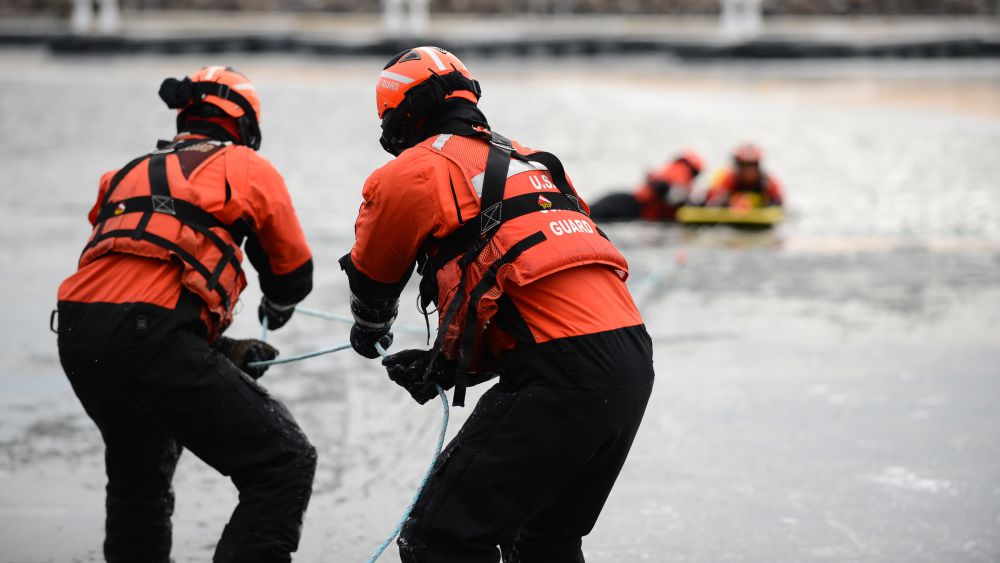Training for an Ice Rescue
Nearly every inch of skin was covered — protected from the invasive cold. Their orange and black dry suits stood in contrast to the frozen lake and distant snowcapped mountains. The team’s spiked boots scraped and dug into the ice leaving pits and scratches on the glass-like surface.
The bulky figures spread out, testing and inspecting the strength of the ice. Carrying long staffs, they poke the solid water seeking weak spots as they move toward the edge of the ice shelf. They call back and forth to each other, constantly communicating and describing the surface they explore.
Approaching the edge they lowered themselves to their reflections and crawled the rest of the way to the open 36-degree water where they would spend their day training.
The crew at Coast Guard Station Burlington, Vermont, on Lake Champlain remains ready in all seasons for the moment they get a search and rescue call. Summers bring sinking and disabled boats, while the winter brings ice fisherman, snowmobilers, ice skaters, and all-terrain vehicle riders testing the limits of the frozen lake. Whatever the conditions or circumstances, the crew has a way to respond to a call for help.
“We train several times a week,” said Petty Officer 1st Class Jason Balmer, an ice rescue trainer at the station. “It’s important to be on top of your game — make sure you’re always ready all the time.”

Balmer has been working in ice rescue since 2002 when he was an ice rescue team member at Station Erie in Pennsylvania. Today, Balmer oversaw the training of new ice rescue team members.
The crew has multiple ways to rescue someone who has fallen through the ice, and Balmer ran each member through the various techniques, stopping at times to explain the nuances of how to properly use the gear.
“A lot of times people panic when they fall through and just hold on to the ice shelf,” said Balmer. “The first thing we do is try to talk them out of the ice.”
Getting out of the ice on your own is known as the self-help technique, and it is one of the first maneuvers ice rescue team members learn.

This technique involves kicking your legs furiously as you hold on to the ice shelf causing your body to become parallel with the ice. While kicking, you attempt to crawl your arms forward pulling yourself out of the freezing waters.” Once you get up, roll away from the hole,” Balmer instructs as the trainee exits the cold water, explaining how staying low and flat distributes weight and helps to prevent falling through the ice again.
Balmer and his crew ran through several more techniques, using yellow rescue slings, rescue shuttle boards, and inflatable ice skiffs.
 As they rotate techniques throughout the morning the driving winds freeze gloves and gear. “It’s good for us,” said Petty Officer 3rd Class Lucas Weston. “We learn how to deal with that, because if we’re out there for several hours looking for someone, or trying to pull someone out of the water we’ll have to deal with frozen equipment.”
As they rotate techniques throughout the morning the driving winds freeze gloves and gear. “It’s good for us,” said Petty Officer 3rd Class Lucas Weston. “We learn how to deal with that, because if we’re out there for several hours looking for someone, or trying to pull someone out of the water we’ll have to deal with frozen equipment.”
“Even with all the equipment we wear we are typically only good for five or six hours, and as the temperature drops the amount of time to perform the rescue drops,” said Balmer.
After a few hours of rotating the team through different scenarios, Balmer calls the training complete. The ice-caked crew piles their gear on top of the shuttle board and drags it back to shore where it is stowed in their ice rescue truck. Once on land they pull off their gloves, goggles, helmets, and neoprene hoods exposing their skin to the cold and generating steam. The team is done training for the day and that much more ready for the next call.
This article appears courtesy of Coast Guard Compass and may be found in its original form here.
